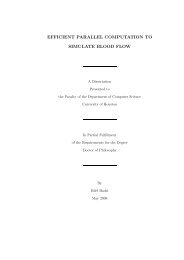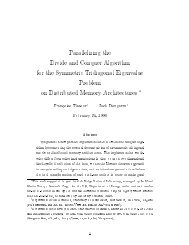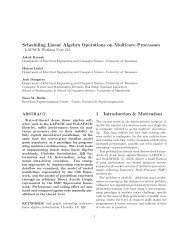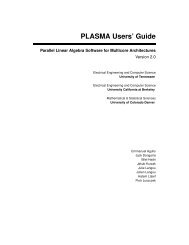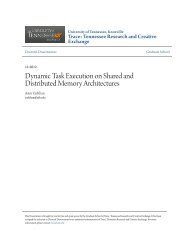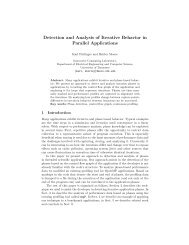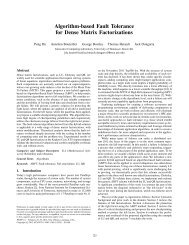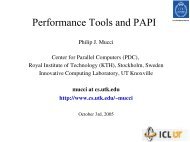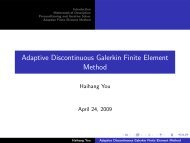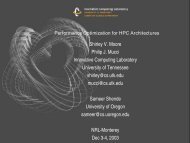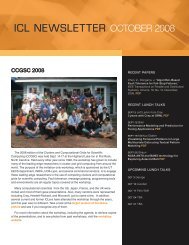Fast and Small Short Vector SIMD Matrix Multiplication ... - The Netlib
Fast and Small Short Vector SIMD Matrix Multiplication ... - The Netlib
Fast and Small Short Vector SIMD Matrix Multiplication ... - The Netlib
Create successful ePaper yourself
Turn your PDF publications into a flip-book with our unique Google optimized e-Paper software.
2 Motivation<br />
<strong>The</strong> current trend in processor design is towards<br />
chips with multiple processing units, commonly referred<br />
to as multi-core processors [3–5]. It has been<br />
postulated that building blocks of future architectures<br />
are likely to be simple processing elements with<br />
shallow pipelines, in-order execution, <strong>and</strong> <strong>SIMD</strong> capabilities<br />
[6]. It has also been poited out that direct<br />
control over the memory hierarchy may be desired,<br />
<strong>and</strong> software-managed scratchpad memory may be<br />
superior to traditional caches [6].<br />
It can be observed that the Synergistic Processing<br />
Element of the CELL processor closely matches this<br />
description. <strong>The</strong>re is no doubt that future processors<br />
will differ significantly from the current designs <strong>and</strong><br />
will reshape the way of thinking about programming<br />
such systems. By the same token, investigation into<br />
micro-kernel development for the SPE may have a<br />
broader impact by providing an important insight into<br />
programming future multi-core architectures.<br />
2.1 Performance Considerations<br />
State of the art numerical linear algebra software utilizes<br />
block algorithms in order to exploit the memory<br />
hierarchy of traditional cache-based systems [7, 8].<br />
Public domain libraries such as LAPACK [9] <strong>and</strong><br />
ScaLAPACK [10] are good examples. <strong>The</strong>se implementations<br />
work on square or rectangular submatrices<br />
in their inner loops, where operations are encapsulated<br />
in calls to Basic Linear Algebra Subroutines<br />
(BLAS) [11], with emphasis on expressing the computation<br />
as Level 3 BLAS, matrix-matrix type, operations.<br />
Frequently, the call is made directly to the matrix<br />
multiplication routine GEMM. At the same time,<br />
all the other Level 3 BLAS can be defined in terms of<br />
GEMM <strong>and</strong> a small amount of Level 1 <strong>and</strong> Level 2<br />
BLAS [12].<br />
A lot of effort has been invested in optimized BLAS<br />
by hardware vendors as well as academic institutions<br />
thorugh projects such as ATLAS [13] <strong>and</strong> GotoBLAS<br />
[14]. At the same time, the inefficiencies<br />
of the BLAS layer have been pointed out [15] as<br />
well as the shortcomings of its fork-join parallelization<br />
model [16]. Owing to this, the emerging trend in<br />
linear algebra is towards the use of specialized data<br />
structures such as Block Data Layout (BDL) [17, 18]<br />
<strong>and</strong> the expression of algorithms directly in terms of<br />
specialized inner-kernels [19]. Although application<br />
of these techniques is not always straightforward,<br />
problems can be often remedied by novel algorithmic<br />
approaches [20, 21].<br />
<strong>The</strong> innovation in CELL software has been progressing<br />
faster than elsewhere, with direct use of<br />
inner-kernels, out-of-order execution <strong>and</strong> Block Data<br />
Layout being a common practice [22–24]. As a result,<br />
performance of algorithms comes much closer<br />
to the speed of GEMM for much smaller problem<br />
sizes [24]. Any improvement to the GEMM routine<br />
immediately benefits the entire algorithm, which<br />
makes the optimization of the GEMM routine yet<br />
more important for the CELL processor.<br />
2.2 Code Size Considerations<br />
In the current implementation of the CELL BE architecture,<br />
the SPEs are equipped with a Local Store of<br />
256 KB. It is a common practice to use tiles of 64×64<br />
elements for dense matrix operations in single precision<br />
[22–26]. Such tiles occupy a 16 KB buffer in<br />
the Local Store. Between six <strong>and</strong> eight buffers are<br />
necessary to efficiently implement even such a simple<br />
operation as matrix multiplication [22, 25, 26].<br />
Also, more complex operations, such as matrix factorizations,<br />
commonly allocate eight buffers [23, 24],<br />
which consume 128 KB of Local Store. In general,<br />
it is reasonable to assume that half of the Local<br />
Store is devoted to application data buffers. At the<br />
same, time the program may rely on library frameworks<br />
like ALF [27] or MCF [28], <strong>and</strong> utilize numerical<br />
libraries such as SAL [29], <strong>SIMD</strong> Math [30] or<br />
MASS [31], which consume extra space for the code.<br />
In the development stage, it may also be desirable to<br />
generate execution traces for analysis with tools like<br />
TATL TM [32] or Paraver [33], which require additional<br />
storage for event buffers. Finally, Local Store also<br />
houses the SPE stack, starting at the highest LS address<br />
<strong>and</strong> growing towards lower addresses with no<br />
overflow protection.<br />
2



